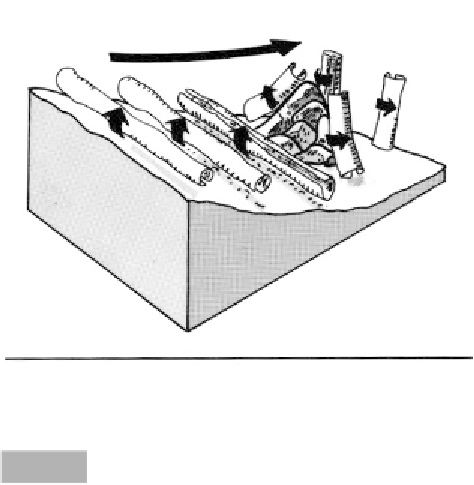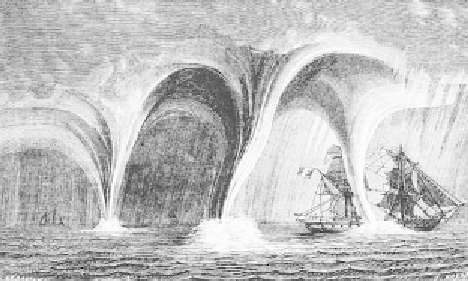Geoscience Reference
In-Depth Information
and are fuelled by massive gaseous explosions within
this rising thermal.
Finally, vortices can easily develop over warm seas,
bays, or lakes under conditions of convective instability
because of the lower friction coefficient of water.
The waterspouts that develop can be impressive
(Figure 4.9); however, wind velocities are considerably
lower than their land counterparts - around 25-25 m
s
-1
- and damage is rare. They often form as multiple
vortices (Figure 4.9). Florida has 50-500 sightings
each year and they are probably just as frequent in
other tropical environments, especially on the eastern
sides of continents where warm water accumulates
under easterly trade winds. Waterspouts that move
inland and kill people are probably tornadoes that have
simply developed first over water. These events are
rare. One of the most notable waterspouts occurred
during Australia's 2001 Sydney Hobart Yacht Race.
The crew of the 24 metre maxi-yacht
Nicorette
video-
taped the approach of an enormous waterspout.
Despite efforts to avoid it, the yacht sailed through the
waterspout, was buffeted by 130 km hr
-1
winds and
hail, but came out the other side with only its mainsail
shredded.
Development of a mountainado from the splitting of a
horizontal vortex rolling along the ground (after Idso, 1976).
Fig. 4.8
a common feature in winter, blowing across the
Rocky Mountains. Vortices have often been produced
with sufficient strength to destroy buildings. Such
vortices behave like small tornadoes and are called
'mountainadoes'.
Strong updrafts can also form because of intense
heating under the influence of fires. Most commonly,
this involves the intense burning of a forest; however,
the earthquake-induced fires that destroyed Tokyo on
2 September 1923, and the fires induced by the
dropping of the atomic bomb on Hiroshima on
6 August 1945, also produced tornadoes. Experiments,
where the atmosphere has been heated from below
using gas burners, commonly have generated twin
vortices on either side of the rapidly rising columns of
air. These fire whirlwinds can vary from a few metres
in height and diameter to fire tornadoes hundreds of
metres high. The most intense and hazardous fire
tornadoes are generated by forest fires, and usually
form on the lee side of hills or ridges during extreme
bushfires or forest fires such as that of the Ash
Wednesday disaster in southern Australia in February
1983. Rising wind velocities can exceed 250 km hr
-1
,
with winds inflowing into the maelstrom reaching
velocities of 100 km hr
-1
. Such
firestorms
pose a
serious, life-threatening hazard for firefighters on the
ground. Fire whirlwinds have been known to lift
flaming debris high into the sky and have snapped off
fully grown trees like matchsticks. In many cases, they
are linked to the convective column above the fire,
An artist's impression of the sailing vessel Trombes being
struck by multiple waterspouts. Sketch first appeared in
Les Meteores, Margolle et Zurcher, 3rd edition, 1869,
page 126 (NOAA, 2003).
Fig. 4.9
Structure of a tornado
Simple tornadoes consist of a funnel, which is virtually
invisible until it begins to pick up debris. Many torna-
does are associated with multiple funnels. In June 1955
a single tornado cloud in the United States produced
13 funnels that reached the ground and left still more
suspended in midair. Generally, the larger the parent
cloud, the greater the number of tornadoes that can be


























